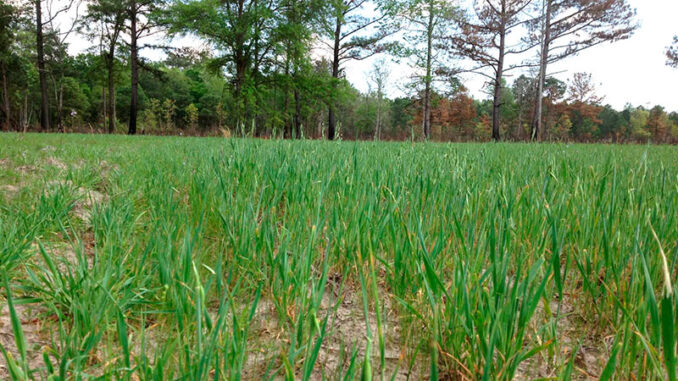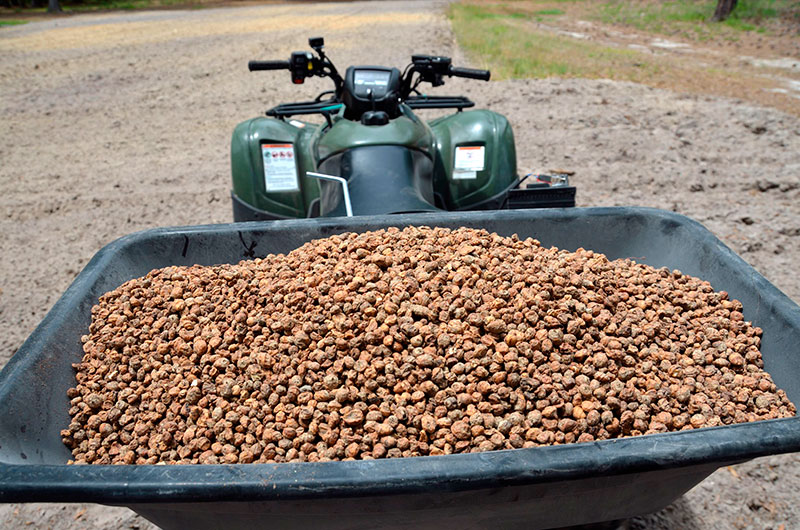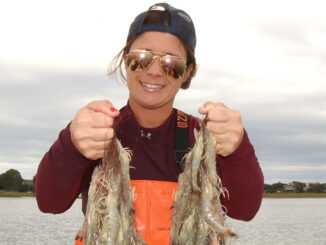
Food plots come in so many different sizes, shapes, and configurations. Fortunately for deer, turkey, and just about all other wildlife, any food plot variety will provide a likable food option and beneficial nutrition to the fur and feathered creatures roaming on Carolina soil.
The spring season is time to plant warm season forage and seed-producers to feed wildlife during the heated months of the year. And it is prime time to get a strong stand of nut grasses underway, and specifically chufa.
What the heck is chufa anyway? Chufa is a nutgrass that produces nutritious and tasty tubers just under the soil. It is mostly grown to fatten up wild turkeys. But make no mistake, deer and just about every other species of wildlife will gobble up these subterranean delights without hesitation. And if flooded, ducks and other waterfowl species will partake in these tubers as well.
Chufa plants grow one to three feet tall and will produce 25 to 75 small, almond-like nuts just under the surface. Wildlife really will not eat the foliage, but the nuts are a delicacy to anything that finds these little golden packages that are full of protein and carbohydrates.
While the spring planting season is prime time for chufa, wildlife will not get a chance to feast on this plant’s goodness until the fall season. Unlike many spring food plot plantings, it’s only the nut-like tubers the animals will eat. They don’t mature and become available until 90 to 110 days after planting.
Easy to grow
Even when the chufa is mature, the nuts may lie dormant and in hiding until some curious turkey or deer digs up a plant to see what is hiding there. Often, landowners will disk up a row of the chufa plants to expose the tubers to the soil surface. And when the deer, turkey, and other wildlife figure out what these plants are and what they possess, then the rest of the chufa plot will get scratched and dug up until every little chufa nut is consumed.

Chufa prefers a sandy, well-drained site with a slightly acidic to near neutral pH. But chufa doesn’t compete well with others grasses and broadleaf plants. However, since chufa is a type of nutsedge, many common grass and broadleaf herbicides can be used in chufa production. For starters, a single application of a pre-emergent herbicide such as Treflan or Prowl (1 quart per acre) can be used to keep other vegetative competition at bay.
If the aggravating grasses start invading stands of chufa during the growing season, Poast can be sprayed over the top at a rate of 1½ quarts per acre and it will instantly knock back any grasses that try to take over. And if the cocklebur or other broadleaf invaders try to take up space, 1½ quarts per acre of 2,4 D will take care of those broadleaf pests too. Chufa is very tolerant to both grass and broadleaf herbicides, which is not typical with most agricultural plantings. Always use crop oils to make sure the herbicides stick to the pesky weed and grasses for maximum effectiveness.
The best months to plant chufa in the Carolinas are between April and June after the threat of any late season frosts. Soil temperatures need to be over 65 degrees for proper germination.
The planting site should be lightly disked initially and then the chufa seeds should be broadcasted rather than planted, as the larger seeds can often get crushed in a typical row planter. Seeds should be broadcasted at a rate of 40 to 50 pounds per acre and then covered by using a chain harrow or disk.
As soon as the tops begin to brown, the tubers are ready for excavation. On some sites, turkeys and deer will know what to do. If they don’t, landowners can dig up a few plants or disk up a row or two to show these guys what they are missing.
They’ll come get it:
Wild turkeys, as well as many other species of wildlife, will bypass other readily-available food sources if they know chufa is nearby. The tubers produced by this plant are high in nutritional value, and many forms of wildlife seem to enjoy the taste of them as well.





Be the first to comment